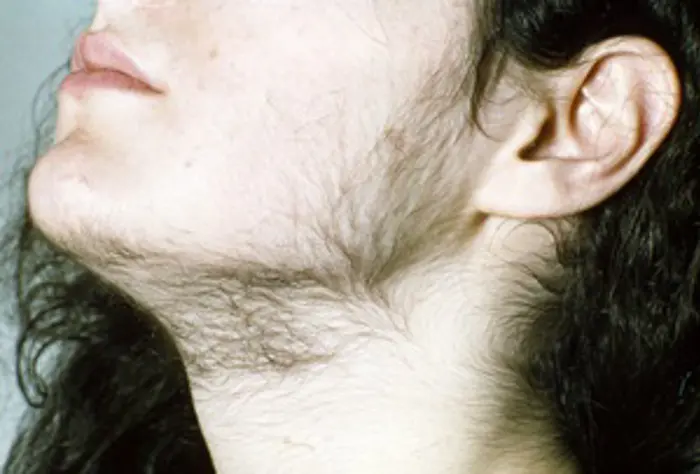Alternative names for hirsutism
Male-pattern hair growth
What is hirsutism?

A young woman with hirsutism.
Hirsutism is a condition that affects women. It is the presence of excessive hair growth in a male pattern, i.e. on the face, chest, upper abdomen, back and thighs.
What causes hirsutism?
Different body regions respond differently to the presence of male and female sex hormones (testosterone and oestrogen, respectively). It is normal for women to have a small amount of testosterone in their system, but there are some medical conditions, such as polycystic ovary syndrome, which cause an imbalance in the levels of sex hormones and, as a consequence, male pattern hair growth can occur.
Rarely, other endocrine conditions such as a testosterone-secreting tumour, Cushing's syndrome (exposure to elevated cortisol hormone levels), acromegaly (overproduction of growth hormone), elevated prolactin levels, congenital adrenal hyperplasia (a genetic disorder that results in low levels of cortisol and high levels of male hormones) and thyroid problems can also cause hirsutism. Sometimes, no underlying abnormality is found and this is termed idiopathic hirsutism.
What are the signs and symptoms of hirsutism?
The areas affected include the face (including upper lip and chin, which can be especially distressing), chest, upper abdomen, back and thighs. The hair is often coarser and darker than normal. It is often accompanied by greasy skin, acne, irregular menstrual periods, oily hair and potentially, male pattern baldness. Depending on the underlying cause, other signs and symptoms may be present.
How common is hirsutism?
Hirsutism is common (5–10% of women), but the extent of it can vary significantly. There are racial differences in hair growth. The point at which hair growth is noted to be excessive may vary depending upon personal and/or societal attitudes.
Is hirsutism inherited?
Genetic factors play a part in how sensitive an individual’s skin is to sex hormones. Polycystic ovary syndrome (PCOS) and idiopathic hirsutism account for 95% of cases, and in half of patients with PCOS there is a family history. All forms of congenital adrenal hyperplasia are genetic.
How is hirsutism diagnosed?
Hirsutism is diagnosed on the basis of the nature and change in pattern of hair growth. It also normally involves a physical examination. The search for an underlying cause involves several hormonal blood tests, which can be performed as an outpatient.
Sometimes imaging tests such as an ultrasound scan of the abdomen, CT scan or MRI may also be required.
Severe and rapidly progressive hirsutism requires a more urgent assessment for an underlying source of testosterone production.
How is hirsutism treated?
Hirsutism can be treated with one or a combination of the following:
- cosmetic treatments such as hair-removing (depilatory) creams, shaving, waxing, electrolysis and laser hair removal. Input from a beautician can provide invaluable support and advice. Eflornithine is a medicated cream that reduces hair growth, so can be used to treat mild to moderate hirsutism. However, its use is currently approved for the facial region only
- weight loss for women who are overweight or obese is also effective in reducing hirsutism
- medications: Moderate or severe hirsutism in polycystic ovarian syndrome can be treated with medications to reduce the body’s effective testosterone, such as the contraceptive pill or medications that increase sensitivity to insulin, such as metformin. Alternatively, drugs that block the actions of testosterone, such as spironolactone, cyproterone and finasteride, can be used. Pregnancy and contraception need to be discussed if patients are being started on these medications. Steroids may be used in congential adrenal hyperplasia. It can take over six months to respond to treatment for hirsutism
- surgery may be required to remove a testosterone producing tumour
Are there any side-effects to the treatment?
Some cosmetic treatments may require repeated courses to remain effective, while hair removal can potentially cause skin irritation and scarring.
If hirsutism is a symptom of polycystic ovary syndrome, there is a huge array of oral contraceptive pill medications available, and different types will suit different patients. Furthermore, the contraceptive pill or cyproterone) can increase the risk of thrombosis (blood clots) so may not be suitable in some patients. Spironolactone can cause low blood pressure and affect the levels of potassium in the blood. In addition, spironolactone, cyproterone and finasteride should not be taken if pregnancy is being considered as they can harm the developing baby. Hence, it is recommended that all women of reproductive age on these medications use adequate contraception. A discussion with your specialist will be needed to agree the best course of treatment and advise on specific side effects.
What are the longer-term implications of hirsutism?
Hirsutism can sometimes have negative effects on self-image, and may result in symptoms of anxiety and depression.

